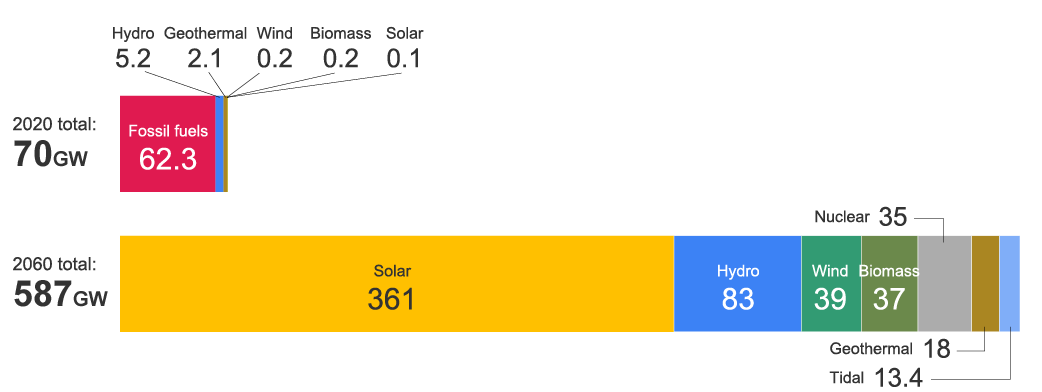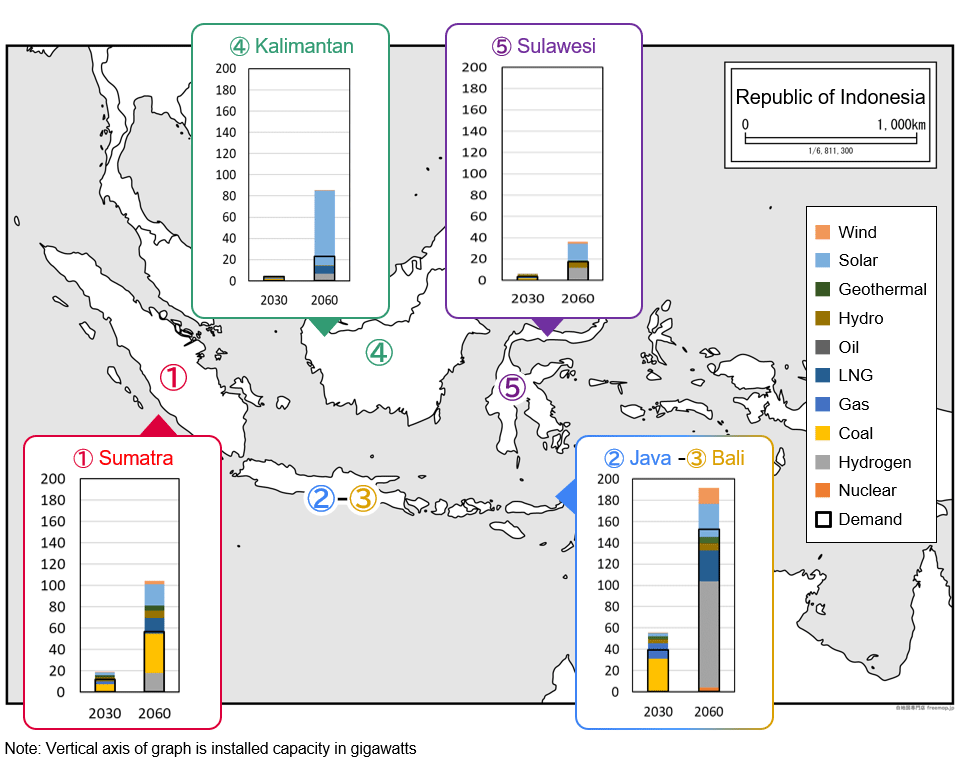Indonesia Using Nuclear Power to Decarbonize and How Japan Can Contribute
Decarbonization drives transformation of Indonesia’s energy landscape
Indonesia has committed to achieving carbon neutrality by 2060, with a targeted power generation mix of around 587 GW. This includes solar (361 GW), hydroelectric (83 GW), wind (39 GW), biomass (37 GW), nuclear (35 GW), geothermal (18 GW), and tidal (13.4 GW) power installations (Figure 1). Thermal power generation accounted for approximately 90% of the total installed capacity in 2020, emphasizing the urgent need for a substantial overhaul in the power generation mix.
This involves moving away from thermal power, embracing renewable energy on a massive scale, and introducing nuclear power. The current government subsidies for electricity bills underscore the difficulty of transitioning to a more costly mix. Striking a balance between economic considerations and achieving this significant transition remains a major hurdle.

Nuclear's promising potential: transforming industrial composition
A growing portion of the Indonesian public also stands behind nuclear, with 76% responding positively toward the introduction of nuclear power in a recent ASEAN survey2. However, transforming the power generation mix will require substantial investment, and effects on the nation’s industrial composition bear critical consideration.
Indonesian industry will face three key issues: establishing new industries to supplant the coal sector, ensuring energy supply for individual islands, and identifying alternative export commodities to replace coal. Nuclear power has potential to be of use in each.
(1) Facilitating a smooth transition: cultivating emerging industries to replace the coal sector
The coal-power workforce could put their skills and knowledge to work in nuclear power generation, aiding in job retention. Human resource development and retraining would be crucial in such a case as not all skills would directly translate. Indonesia too can benefit from nuclear power’s potential to foster new industries and job opportunities by leveraging existing infrastructure and skilled labor.
(2) Tapping into power: tailored solutions to address the varied energy needs of individual islands
Given this, the introduction of traditional large light-water reactors (i.e. 300 MW or more) may lead to an oversupply issue. A more promising alternative lies in the deployment of small modular reactors (SMRs) with a capacity of 300 MW or less and micro reactors with a capacity of 10 MW or less, both the focus of recent research and development efforts.
Canada, facing similar challenges in power grid connectivity and supply-demand balance, is already undertaking the construction of SMRs and micro reactors with plans for operation to begin around 2030. In comparison to large light-water reactors, SMRs and micro reactors offer the advantage of lower initial investment, albeit with a slightly higher overall unit cost of power generation. Choosing the appropriate reactor type to introduce should consider factors such as overall electricity demand, the integration of renewable energy, power grid infrastructure, and economic feasibility.

(3) Broadening export horizons: exploring resources to replace coal
Exporting hydrogen generated through nuclear power presents itself as a potential solution. The Japanese government is currently working on a demonstration version of a High-Temperature Gas-Cooled Reactor (HTGR). The country looks to develop the technology to achieve a price of around 0.1 USD/Nm3*.5 Indonesia's strategy could include the introduction of HTGRs, transitioning from power generation to hydrogen production during periods of excess electricity supply, and subsequently exporting the resultant products.
*Nm3 is an abbreviation for normal lube and is equivalent to one cubic meter of gas in its standard state
Japan can help with technology and training
Effective earthquake and tsunami countermeasures are needed in seismically-intense Indonesia, and Japan's experience following the Fukushima nuclear accident is particularly valuable. Japan's leadership in HTGR technology offers opportunities for collaboration in the development of both technology and human resources. Programs by the Japan Atomic Energy Agency and various universities have brought students, engineers, and researchers from Indonesia to Japan to take part in nuclear-related human resource development programs, but new programs need to be set up that align with Indonesia's nuclear power introduction plan.
In Japan, the number of university students majoring in nuclear power has flattened out since the Fukushima accident—the nuclear power field could face an existential crisis6. More resources must also be devoted to the completion of decommissioning projects. Amid this, collaboration with Indonesia in the nuclear field may provide new opportunities for Japanese companies struggling to pass on their technologies.
Indonesia's quest for a substantial shift in its power generation mix to achieve carbon neutrality underscores the pivotal role nuclear can play in fostering domestic industries, maintaining a balanced electricity supply and demand, and establishing export industries. Leveraging Japan's technology and experience becomes crucial in realizing the peaceful and secure utilization of nuclear energy in Indonesia.
Works cited
1Ministry of Energy and Mineral Resources (November 2021) “Indonesia's NRE Development in Energy Transition towards Net Zero Emission”
https://britcham.or.id/
2ASEAN Centre for Energy (September 2022) "The 7th ASEAN Energy Outlook"
https://aseanenergy.org/
3PLN (October 2021) “Electricity Supply Plan 2021-2030”
https://gatrik.esdm.go.id/
4US Department of Energy (September 2022) "Could the Nation's Coal Plant Sites Help Drive a Clean Energy Transition?"
https://www.energy.gov/
5Agency for Natural Resources and Energy "HTGR Demonstration Reactor Development Project"
https://www.meti.go.jp/
6MRI Research Associates (March 2021) "Report on the Baseline Study for Securing and Training Future Human Resources for the Nuclear Field" Cabinet Office https://wwwa.cao.go.jp/oaep/


